Evaluation of Water Balance and Water Use Efficiency with the Development of Water-Saving Irrigation in the Yanqi Basin Irrigation District of China
Abstract
1. Introduction
2. Materials and Methods
2.1. Study Area
2.2. Data
2.3. Water Balance Analysis
2.4. Irrigation Water Used Efficiency Analysis
2.4.1. Traditional Water Use Efficiency Indicators
2.4.2. Improved IWMI Water Balance Method
3. Results
3.1. Irrigation District Development in the Kaidu River Irrigation District
3.2. Analysis of Water Supply and Demand in Irrigation Districts
3.3. Characteristics of Water Supply, Drainage and Consumption in the District
3.4. Variation in Irrigation Water Use Efficiency in the District
3.4.1. Traditional Water Use Efficiency Indicators
3.4.2. Improved IWMI Water Balance Method
4. Discussion
4.1. Effect of Water-Saving Irrigation on Water Balance in the District
4.2. Suggestions for Avoiding the Paradox of Irrigation Efficiency
5. Conclusions
Author Contributions
Funding
Data Availability Statement
Acknowledgments
Conflicts of Interest
References
- Zhang, K.; Yu, F. Research on green agricultural development under the dual-carbon goal: Review and perspectives. Chin. J. Eco-Agric. 2022, 31, 214–225. [Google Scholar] [CrossRef]
- Fang, S.; Jia, R.; Tu, W.; Sun, Z. Assessing Factors Driving the Change of Irrigation Water-Use Efficiency in China Based on Geographical Features. Water 2017, 9, 759. [Google Scholar] [CrossRef]
- Forslund, A.; Renoefaelt, B.M.; Barchiesi, S.; Smith, D.M. Securing Water for Ecosystems and Human Well-Being: The Importance of Environmental Flows; Swedish International Water Institute: Stockholm, Sweden, 2022. [Google Scholar]
- Luo, C.; Feng, L.; Chai, Z.; Zhang, W.; Wang, Z. Study on Sustainable Utilization of agricultural water resources in Xinjiang. 2022, 10, pp. 560–569. Available online: https://kns.cnki.net/kcms2/article/abstract?v=AnuRcxOpZiE7xHqDZrn47NVLaklKqIdG-PinP3ReZMZIBPV3Gp__KlffzWrqxIpsgcJCW09B9wEMwriLGWj0JxeQ8j_mHApSdo96-kaMZkoBPRi8Zd6yrrHqOhepShFIaez2oUxlpeZKHz5iKInRiA==&uniplatform=NZKPT&language=CHS (accessed on 4 December 2023).
- Li, X. China—Water Conservation Project II: P114138—Implementation Status Results Report: Sequence 04 (English). Available online: http://www-wds.worldbank.org/external/default/main?pagePK=64193027&piPK=64187937&theSitePK=523679&menuPK=64187510&searchMenuPK=64187511&entityID=090224b0823cd337_1_0&cid=3001_39 (accessed on 4 December 2023).
- Long, A.; Deng, M. A Study of the Water Balance of Lake Balkhash. J. Glaciol. Geocryol. 2011, 33, 1341–1352. [Google Scholar] [CrossRef]
- Jiang, D. A Review on the Classification and Calculating Methods of Ecological and Environmental Water Requirements. Prog. Geogr. 2003, 22, 369–378. [Google Scholar]
- Feng, H.; Zheng, H.; Cao, Y. On Theories and Methodologies of Ecological Water Demand Estimation. J. Nanjing Xiaozhuang Coll. 2005, 21, 50–55. [Google Scholar]
- Hong, F.; Ning, C.; Hong, L. Impact of Global Warming on Water Requirement of Main Crops in Oasis Irrigated Area in Yanqi Basin. Adv. Mater. Res. 2014, 955, 3079–3087. [Google Scholar]
- Wang, W.; Zhao, Q.; Du, J. Advances in the Study of Evapotranspiration of Regional Land Surface Based on Remote Sensing Technology. Remote Sens. Land Resour. 2012, 24, 1–7. [Google Scholar]
- Gao, D. Progress in Models for Evapotranspiration Estimation Using Remotely Sensed Data. J. Remote Sens. 2008, 12, 515–528. [Google Scholar]
- Bastiaanssen, W.G.M.; Molden, D.J.; Makin, I.W. Remote sensing for irrigated agriculture: Examples from research and possible applications. Agric. Water Manag. 2000, 46, 137–155. [Google Scholar] [CrossRef]
- Yang, Y.; Shang, S. A hybrid dual-source scheme and trapezoid framework–based evapotranspiration model (HTEM) using satellite images: Algorithm and model test. J. Geophys. Res. Atmos. 2013, 118, 2284–2300. [Google Scholar] [CrossRef]
- Yang, Y.; Yang, P.; Wang, C.; Kou, X.; Tan, F.; Xu, J.; Wang, C. Effectiveness evaluation of water consumption in agricultural land of Yanqi Basin, Xinjiang. Arid Land Geogr. 2023, 46, 730–741. [Google Scholar]
- Tang, H. Progress and Prospect of Agricultural Remote Sensing Research. J. Agric. 2018, 8, 175. [Google Scholar]
- Kang, S.; Hao, X.; Du, T.; Tong, L.; Su, X.; Lu, H.; Li, X.; Huo, Z.; Li, S.; Ding, R. Improving agricultural water productivity to ensure food security in China under changing environment: From research to practice. Agric. Water Manag. 2017, 179, 5–17. [Google Scholar] [CrossRef]
- Wu, P.; Feng, H.; Niu, W.; Gao, J.e.; Jiang, D.; Wang, Y.; Fan, X.; Qi, P. Analysis of developmental tendency of water distribution and water-saving strategies. Trans. Chin. Soc. Agric. Eng. Trans. CSAE 2003, 19, 1–6. [Google Scholar]
- Zhang, W.; Du, X.; Huang, A.; Yin, H. Analysis and Comprehensive Evaluation of Water Use Efficiency in China. Water 2019, 11, 2620. [Google Scholar] [CrossRef]
- Wallace, J.S. Increasing agricultural water use efficiency to meet future food production. Agric. Ecosyst. Environ. 2000, 82, 105–119. [Google Scholar] [CrossRef]
- Wang, H.; Zhang, L.; Dawes, W.R.; Liu, C. Improving water use efficiency of irrigated crops in the North China Plain—Measurements and modelling. Agric. Water Manag. 2001, 48, 151–167. [Google Scholar] [CrossRef]
- Lilienfeld, A.; Asmild, M. Estimation of excess water use in irrigated agriculture: A Data Envelopment Analysis approach. Agric. Water Manag. 2007, 94, 73–82. [Google Scholar] [CrossRef]
- André, F.J.; Herrero, I.; Riesgo, L. A modified DEA model to estimate the importance of objectives with an application to agricultural economics. Omega 2010, 38, 371–382. [Google Scholar] [CrossRef]
- Varghese, S.K.; Veettil, P.C.; Speelman, S.; Buysse, J.; Van Huylenbroeck, G. Estimating the causal effect of water scarcity on the groundwater use efficiency of rice farming in South India. Ecol. Econ. 2013, 86, 55–64. [Google Scholar] [CrossRef]
- Drew, M.; Crase, L. ‘More Crop per Drop’ and water use efficiency in the National Water Policy of Pakistan. Agric. Water Manag. 2023, 288, 108491. [Google Scholar] [CrossRef]
- Li, Y.; Fan, L.; Wang, J.; Luo, W. An Analysis of the Irrigation Water Use Efficiency Indicators in Changjiang River Basin. China Rural Water Hydropower 2017, 12, 1–6+12. [Google Scholar] [CrossRef]
- Cui, Y.; Xiong, J. Advances in assessment indicators of irrigation water use efficiency. Adv. Water Sci. 2009, 20, 590–598. [Google Scholar]
- Seckler, D.; Amarasinghe, U.A.; Molden, D.J.; De Silva, R.; Barker, R. World water demand and supply, 1990 to 2025: Scenarios and issues. IWMI Res. Rep. 1998, 19, 6–49. [Google Scholar] [CrossRef]
- Willardson, L.S.; Allen, R.G.; Frederiksen, H.D. Elimination of Irrigation Efficiencies. 1994. Available online: https://www.researchgate.net/publication/253580547_Eliminating_Irrigation_Efficiencies (accessed on 4 December 2023).
- International Water Management Institute. Integrated Water Resource Systems: Theory and Policy Implications (Keller/Keller/David Seckler/IIMI); International Water Management Institute: Colombo, Sri Lanka, 1999. [Google Scholar]
- International Water Management Institute. International Water Management Institute (IWMI). International Water Management Institute: Colombo, Sri Lanka, 2015. [Google Scholar]
- Bin, D. An Introduction of the Framework for Water Accounting and Performance Indicators Developed by IWMI. China Rural Water Hydropower 2003, 1, 5–8. [Google Scholar] [CrossRef]
- Molden, D. Accounting for Water Use and Productivity; Iwmi: Colombo, Sri Lanka, 1997. [Google Scholar] [CrossRef]
- Cui, Y.; Dong, B.; Li, Y.; Cai, X. Assessment indicators and scales of water saving in agricultural irrigation. Trans. Chin. Soc. Agric. Eng. 2007, 23, 1–7. [Google Scholar]
- Bastiaanssen, W.G.M.; Brito, R.A.L.; Bos, M.G.; Souza, R.A.; Cavalcanti, E.B.; Bakker, M.M. Low Cost Satellite Data for Monthly Irrigation Performance Monitoring: Benchmarks from Nilo Coelho, Brazil. Irrig. Drain. Syst. 2001, 15, 53–79. [Google Scholar] [CrossRef]
- Bos, M.G. Using the depleted fraction to manage the groundwater table in irrigated areas. Irrig. Drain. Syst. 2004, 18, 201–209. [Google Scholar] [CrossRef][Green Version]
- Zhou, X. Sustainability assessment and improvement strategies research for typical arid and resource-developing regions. PLoS ONE 2021, 16, e0251088. [Google Scholar] [CrossRef]
- Cui, Y. The Research on Agricultural Eco-Efficiency in Xinjiang. Ph.D. Thesis, Shihezi University, Xinjiang, China, 2022. [Google Scholar] [CrossRef]
- Peng, H. Analysis on the status of water-saving irrigation techniques and its development trends in China. Soil Fertil. Sci. China 2006, 5, 1–6. [Google Scholar]
- Li, Y. An Economic Analysis of Sustainable Utilization of Water Resources in Agricultural Production. Ph.D. Thesis, Nanjing Agricultural University, Nanjing, China, 2004. [Google Scholar]
- Wang, J.; Wu, J.; Qi, X.; Yang, B.; Zhao, H.; Fan, X. Advances in water saving irrigation evaluation. Adv. Water Sci. 2002. [Google Scholar] [CrossRef]
- Xiong, R.; Zheng, Y.; Han, F.; Tian, Y. Improving the Scientific Understanding of the Paradox of Irrigation Efficiency: An Integrated Modeling Approach to Assessing Basin-Scale Irrigation Efficiency. Water Resour. Res. 2021, 57, e2020WR029397. [Google Scholar] [CrossRef]
- Contor, B.A.; Taylor, R.G. Why improving irrigation efficiency increases total volume of consumptive use. Irrig. Drain. 2013, 62, 273–280. [Google Scholar] [CrossRef]
- Zhong, Y.; Gan, L. Study on the Path of Ensuring Grain Security in Northwest Arid Area Under the Constraint of esources. Acad. J. Zhongzhou 2022. [Google Scholar]
- Wang, Y.; Li, Y.; Wang, Y.; Tan, Y. Study on the Change of Inflow and Salt Content of the Bosten Lake, Xinjiang since the 1950s. Arid Zone Res. 2005, 22, 355–360. [Google Scholar]
- Hu, S.; Guo, J.; Cheng, B.; Wang, F.; Tian, C.; Pan, Y. Analysis on the Feasibility of Reusing the Drained Water from the Farmlands in the Shajingzi Irrigated Area, Xinjiang. Arid Zone Res. 2004, 12, 343–349. [Google Scholar]
- Liu, H.; Song, J. Discussion on Protection of Bositeng Lake Water Area and Wetland. Res. Soil Water Conserv. 2004, 11, 150–151. [Google Scholar]
- Tian, F. Characterizing Spatiotemporal Patterns of Snowfall in the Kaidu River Basin from 2000–2020 Using MODIS Observations. Remote Sens. 2022, 14, 5885. [Google Scholar]
- Zhang, Y.; Li, B.; Bao, A.; Zhou, C.; Xi, A.C. Study on snowmelt runoff simulation in the Kaidu River basin. Sci. China Ser. D 2007, 50, 26–35. [Google Scholar] [CrossRef]
- Liu, C.; Wang, H. An analysis of relationship between water resources and population-aconomy-society-environmet. J. Nat. Resour. 2003, 5, 635–644. [Google Scholar] [CrossRef]
- Grafton, R.Q.; Williams, J.; Perry, C.J.; Molle, F.; Ringler, C.; Steduto, P.; Udall, B.; Wheeler, S.A.; Wang, Y.; Garrick, D.; et al. The paradox of irrigation efficiency. Science 2018, 361, 748–750. [Google Scholar] [CrossRef] [PubMed]
- Zhang, C.; Fang, J.; Feng, L. Review of Eco-Hydrology in Arid and Semi- Arid Regions. Hunan Agric. Sci. 2014, 17, 35–37+41. [Google Scholar] [CrossRef]
- Han, S.; Hu, H.; Yang, D.; Liu, Q. Irrigation impact on annual water balance of the oases in Tarim Basin, Northwest China. Hydrol. Process. 2011, 25, 167–174. [Google Scholar] [CrossRef]
- Mei, X.; Kang, S.; Yu, Q.; Huang, Y.; Zhong, X.; Gong, D.; Huo, Z.; Liu, E. Pathways to Synchronously Improving Crop Productivity and Field Water Use Efficiency in the North China Plain. Sci. Agric. Sin. 2013, 46, 1149–1157. [Google Scholar]
- Li, H.; Liu, H.; Gong, X.; Li, S.; Pang, J.; Chen, Z.; Sun, J. Optimizing irrigation and nitrogen management strategy to trade off yield, crop water productivity, nitrogen use efficiency and fruit quality of greenhouse grown tomato. Agric. Water Manag. 2021, 245, 106570. [Google Scholar] [CrossRef]
- Shang, S.; Jiang, L.; Yang, Y. Review of Remote Sensing-based Assessment Method for Irrigation and Crop Water Use Efficiency. Trans. Chin. Soc. Agric. Mach. 2015, 46, 81–92. [Google Scholar] [CrossRef]
- Li, R.; Liu, X. Advance of Research on Utilization Coefficient of Irrigation water. Water Sav. Irrig. 2011, 11, 56–58. [Google Scholar]
- Perry, C. Reply: Efficient irrigation; inefficient communication; flawed recommendations: Response to comment. Irrig. Drain. 2008, 57, 249–252. [Google Scholar] [CrossRef]
- Waller, P.; Yitayew, M. Irrigation and Drainage Engineering; Springer: Berlin/Heidelberg, Germany, 2016. [Google Scholar] [CrossRef]
- Keller, A.; Keller, J.; Seckler, D. Integrated water resource systems: Theory and policy implications. Iwmi Books Rep. 1996, 3, 6–22. [Google Scholar] [CrossRef]
- Burt, C.M.; Clemmens, A.J.; Strelkoff, T.S.; Solomon, K.H.; Eisenhauer, D.E. Irrigation Performance Measures: Efficiency and Uniformity. J. Irrig. Drain. Eng. 1999, 125, 97–99. [Google Scholar] [CrossRef]
- Kooij, S.V.D. Fieldwork plan 2012. Beyond irrigation efficiency. J. Oral Maxillofac. Surg. Off. J. Am. Assoc. Oral Maxillofac. Surg. 1987, 45, 779–784. [Google Scholar]
- Perry, C.J. The IWMI water resources paradigm—Definitions and implications. Agric. Water Manag. 1999, 40, 45–50. [Google Scholar] [CrossRef]
- Karimi, P.; Bastiaanssen, W.G.M.; Molden, D. Water Accounting Plus (WA+)—A water accounting procedure for complex river basins based on satellite measurements. Hydrol. Earth Syst. Sci. 2013, 17, 2459–2472. [Google Scholar] [CrossRef]
- Molden, D.J.; Sakthivadivel, R. Water Accounting to Assess Use and Productivity of Water. Int. J. Water Resour. Dev. 1999, 15, 55–71. [Google Scholar] [CrossRef]
- Yan, N.; Wu, B. Integrated spatial–temporal analysis of crop water productivity of winter wheat in Hai Basin. Agric. Water Manag. 2014, 133, 24–33. [Google Scholar] [CrossRef]
- Zhang, J.; Zhou, H.; CAS. Land Use and Land Cover Change of Yanqi Basin, Xinjiang in the Resent 40 Years. Resour. Sci. 2004, 26, 30–37. [Google Scholar]
- Jiao, Z. Application of High Efficiency Water-saving Irrigation Technology in Farmland Water Conservancy Project. Mod. Agric. Res. 2019, 2, 100–102. [Google Scholar] [CrossRef]
- Liao, Y.; Dong, Y.; Chen, X.; Liang, Y.; Wang, S.; Zhang, W. Water-Saving Technology in Irrigation. Appl. Mech. Mater. 2012, 178–181, 847–850. [Google Scholar] [CrossRef]
- Bazza, M. Policies for water management and food security under water-scarcity conditions: The case of GCC countries. In Proceedings of the 7th Gulf Water Conference, Kuwait, Kuwait, 19–23 November 2005; pp. 19–23. [Google Scholar]
- Varela-Ortega, C. Water pricing policies, public decision making and farmers’ response: Implications for water policy. Agric. Econ. 1998, 19, 193–202. [Google Scholar] [CrossRef]

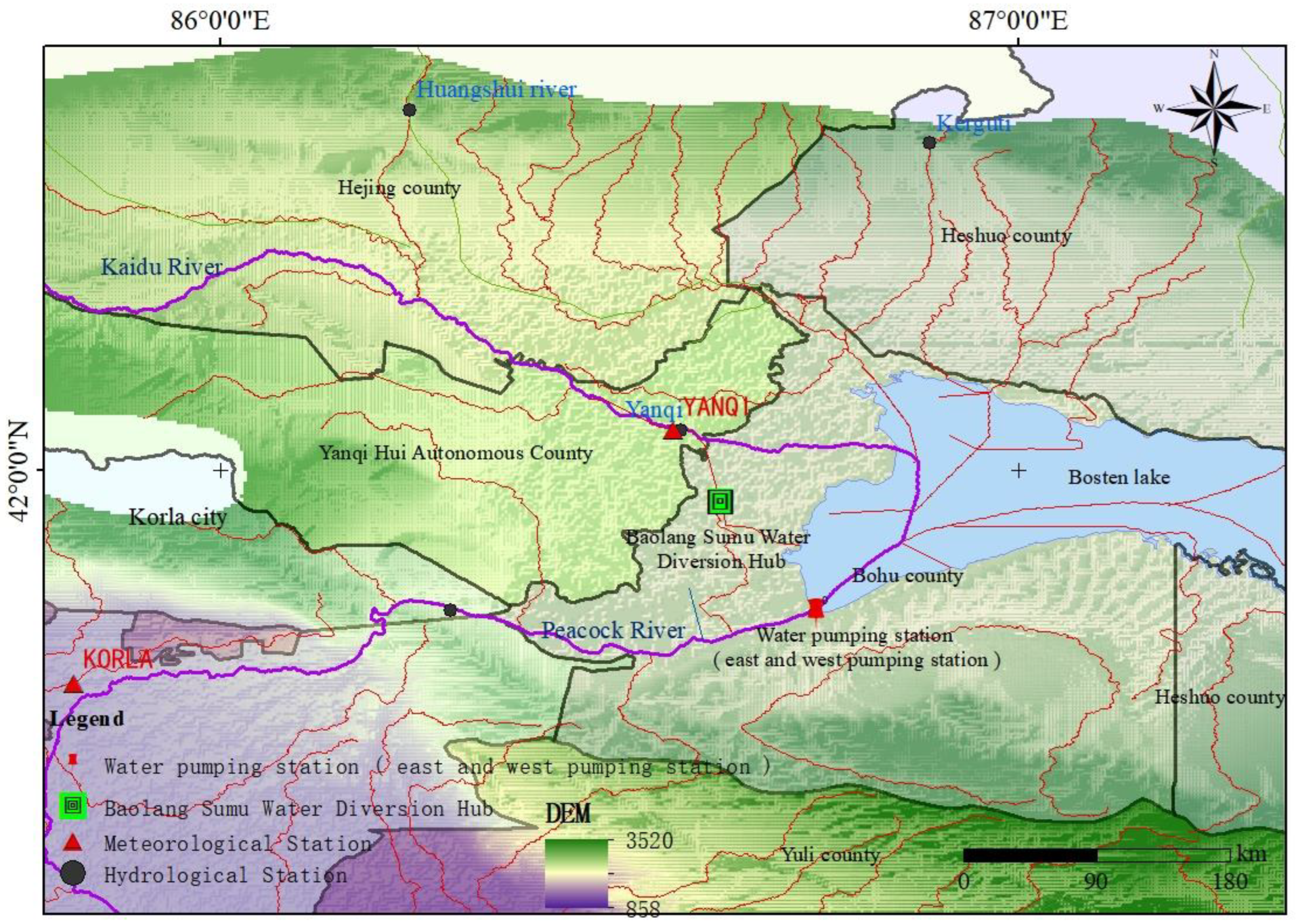
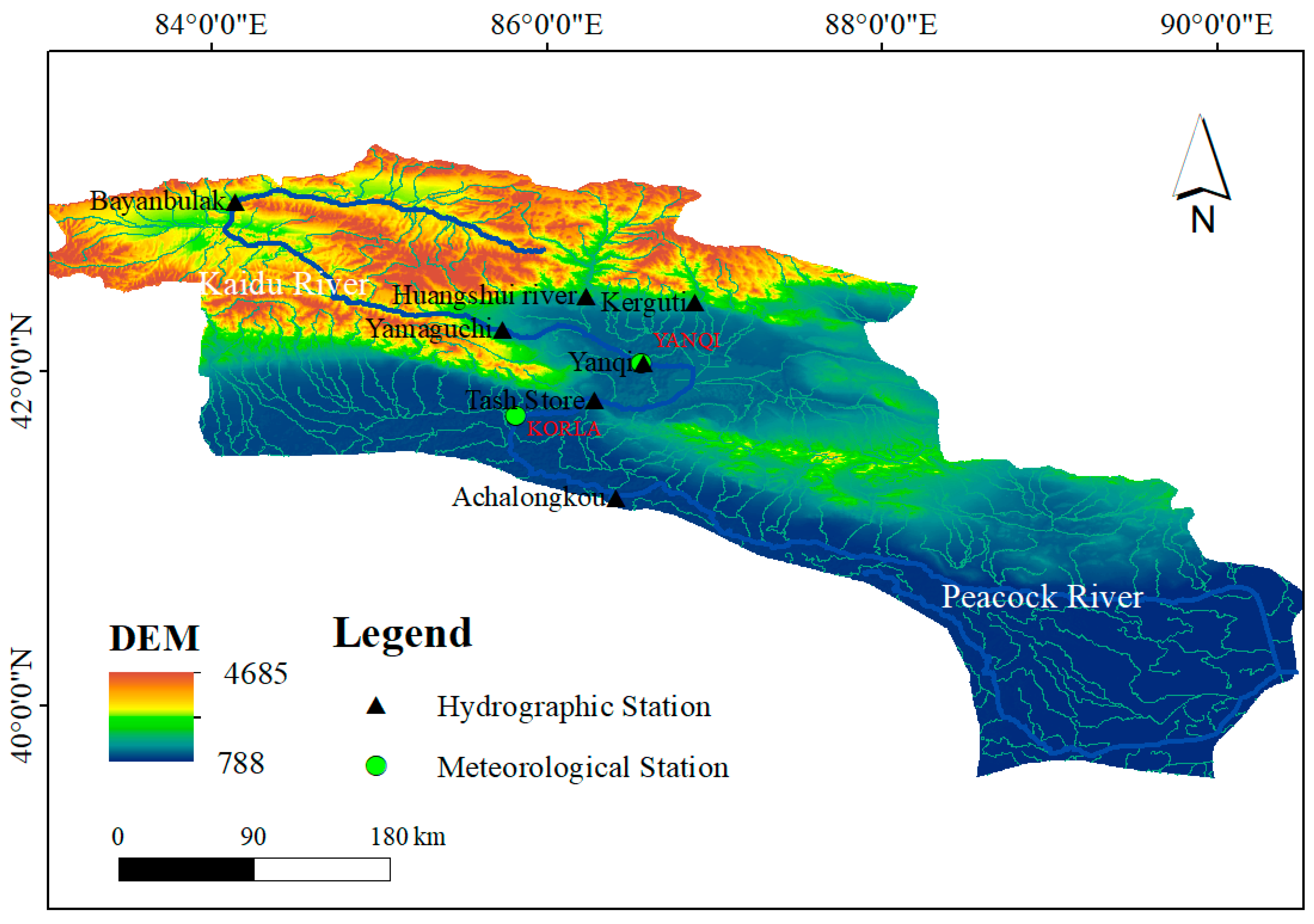



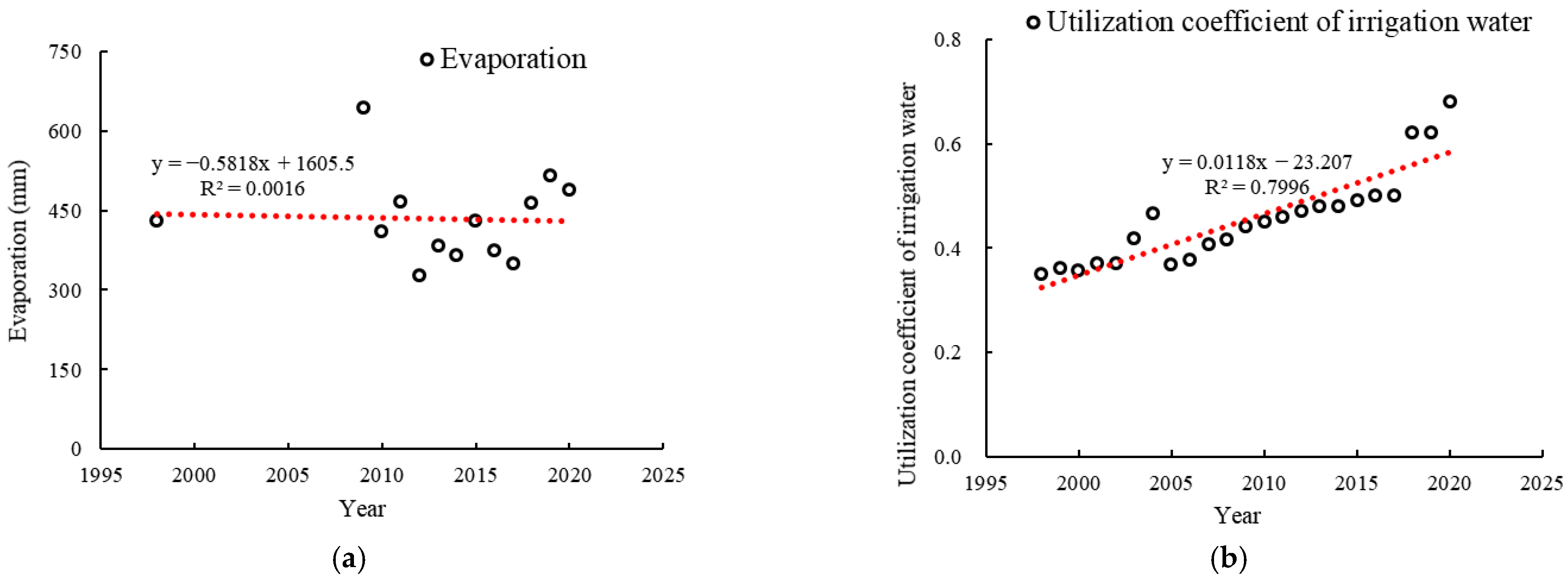

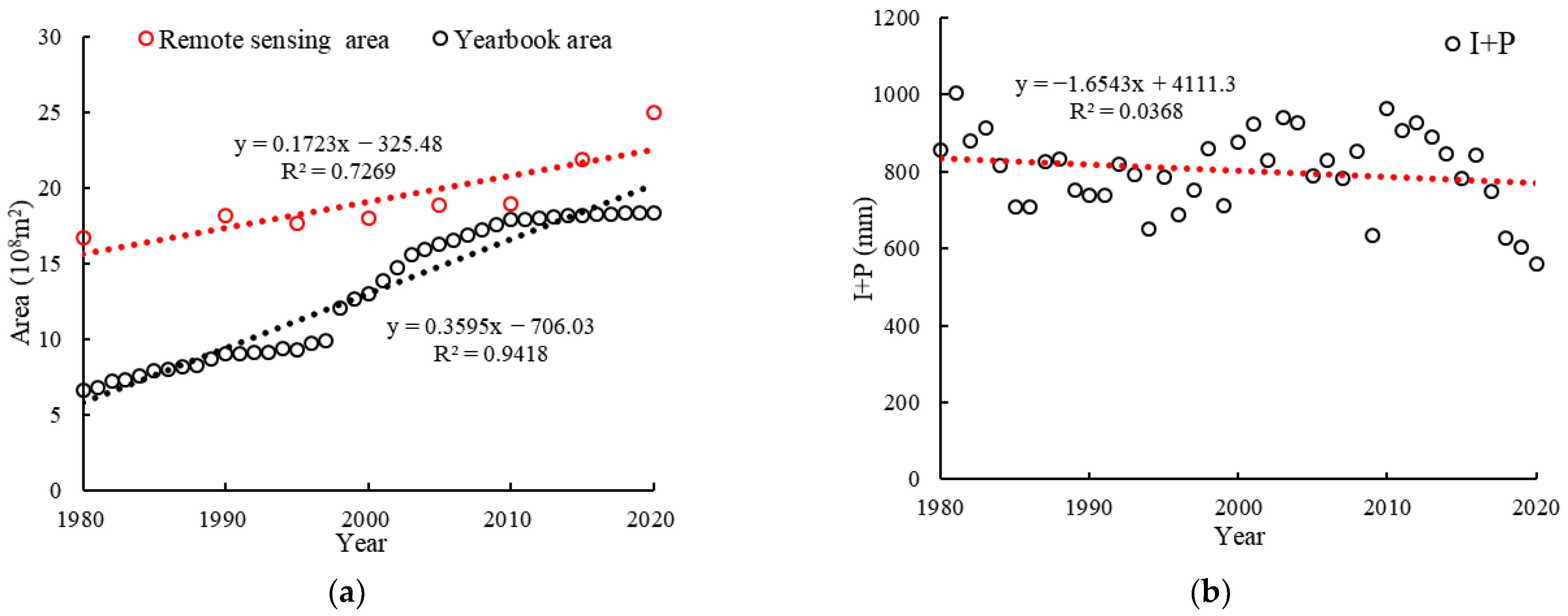
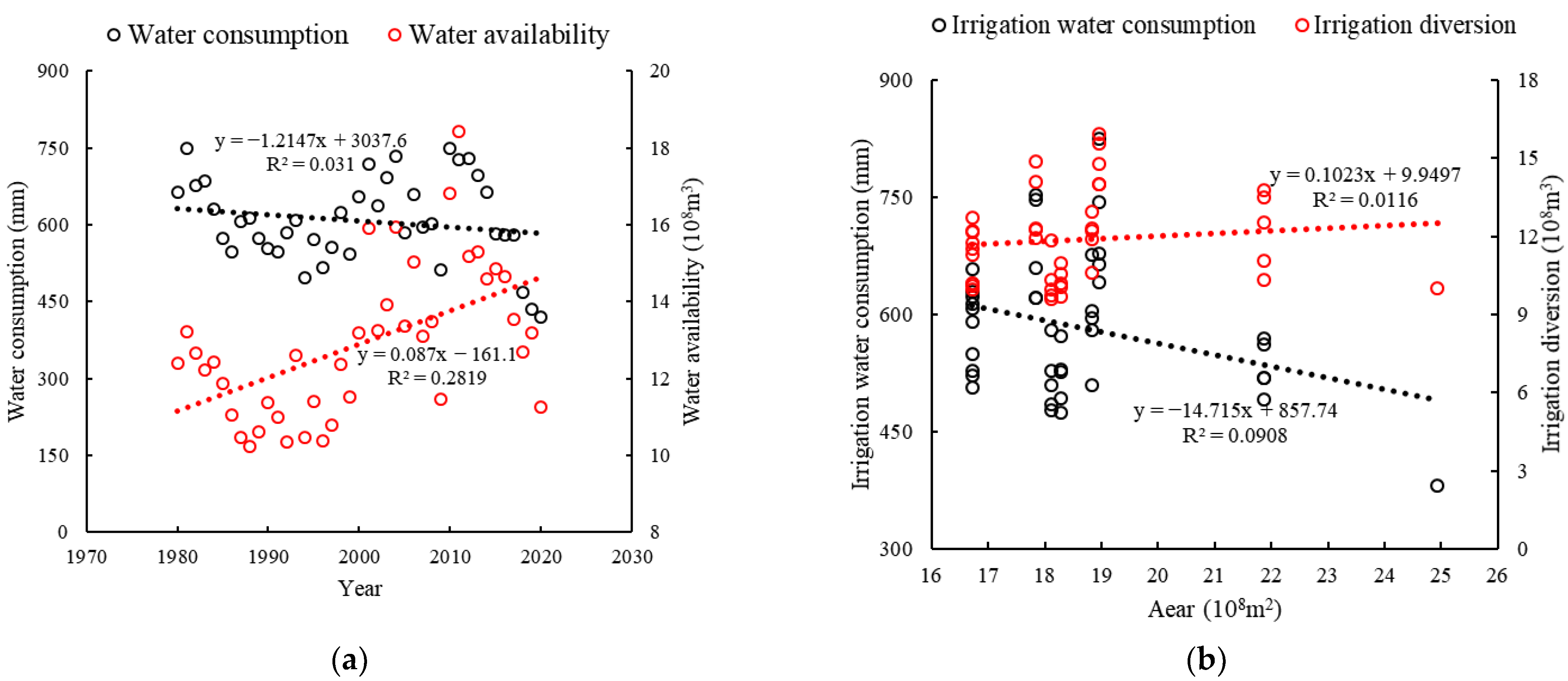
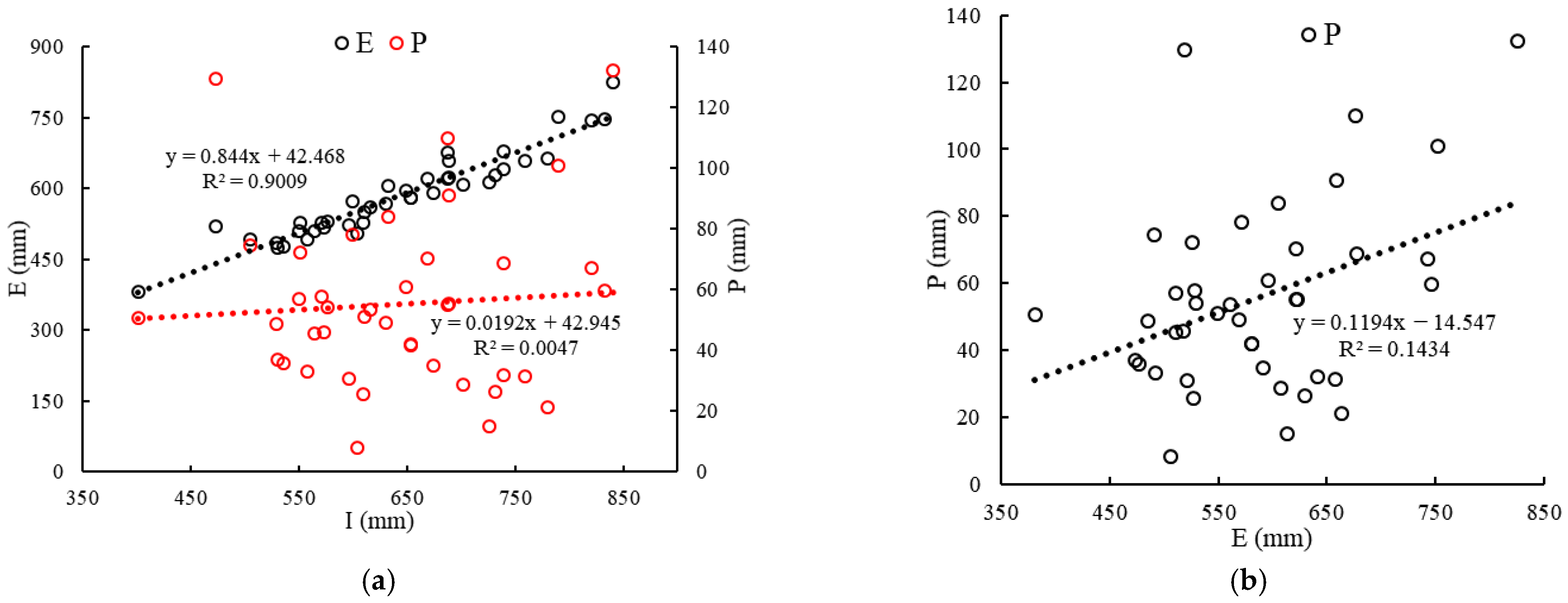
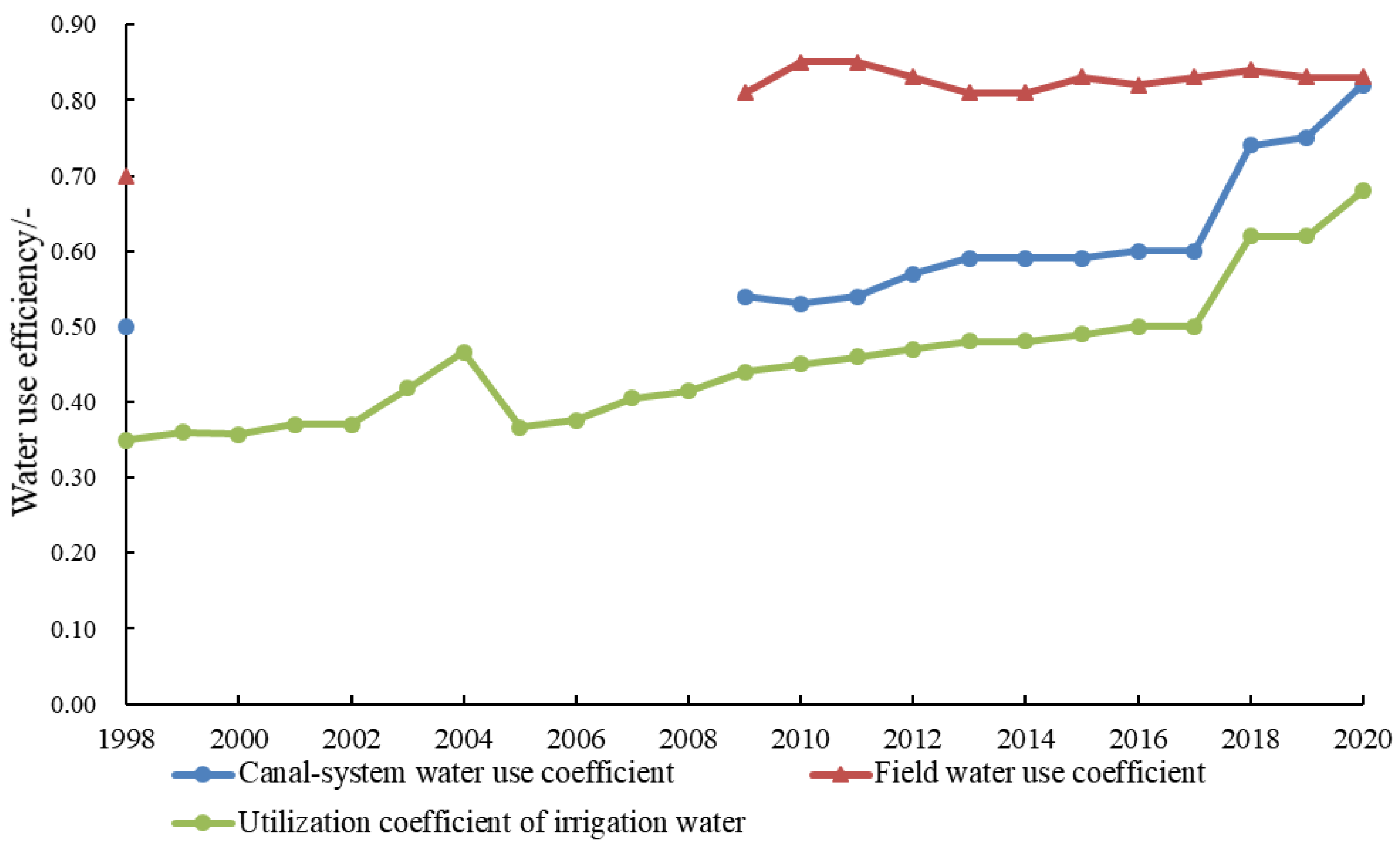

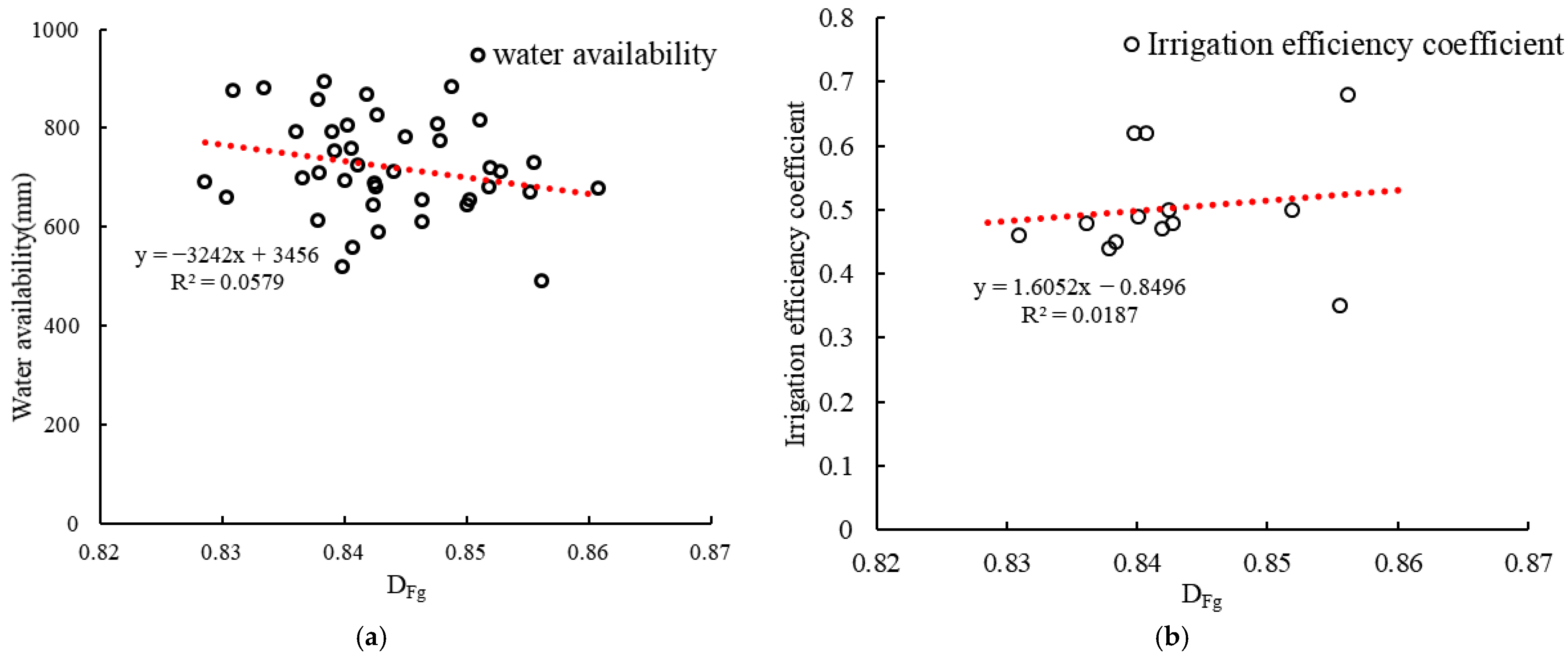
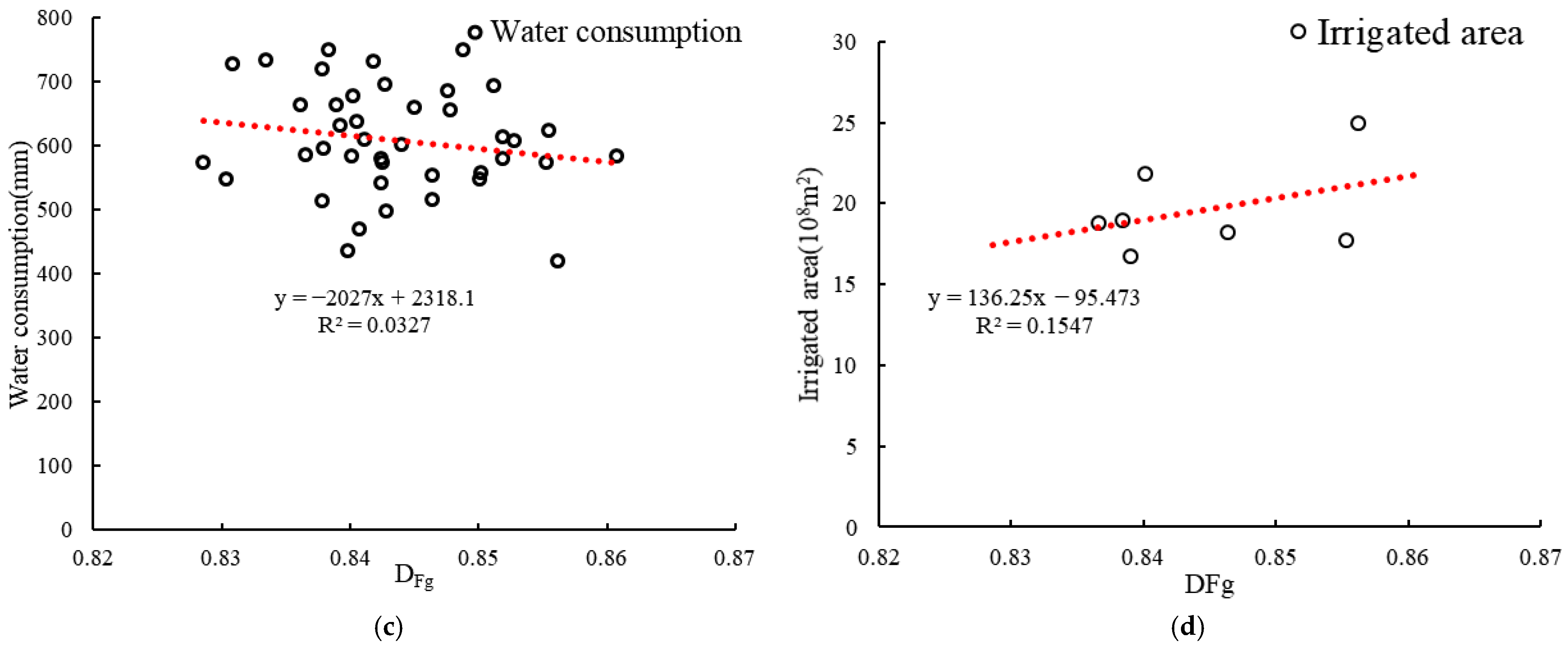
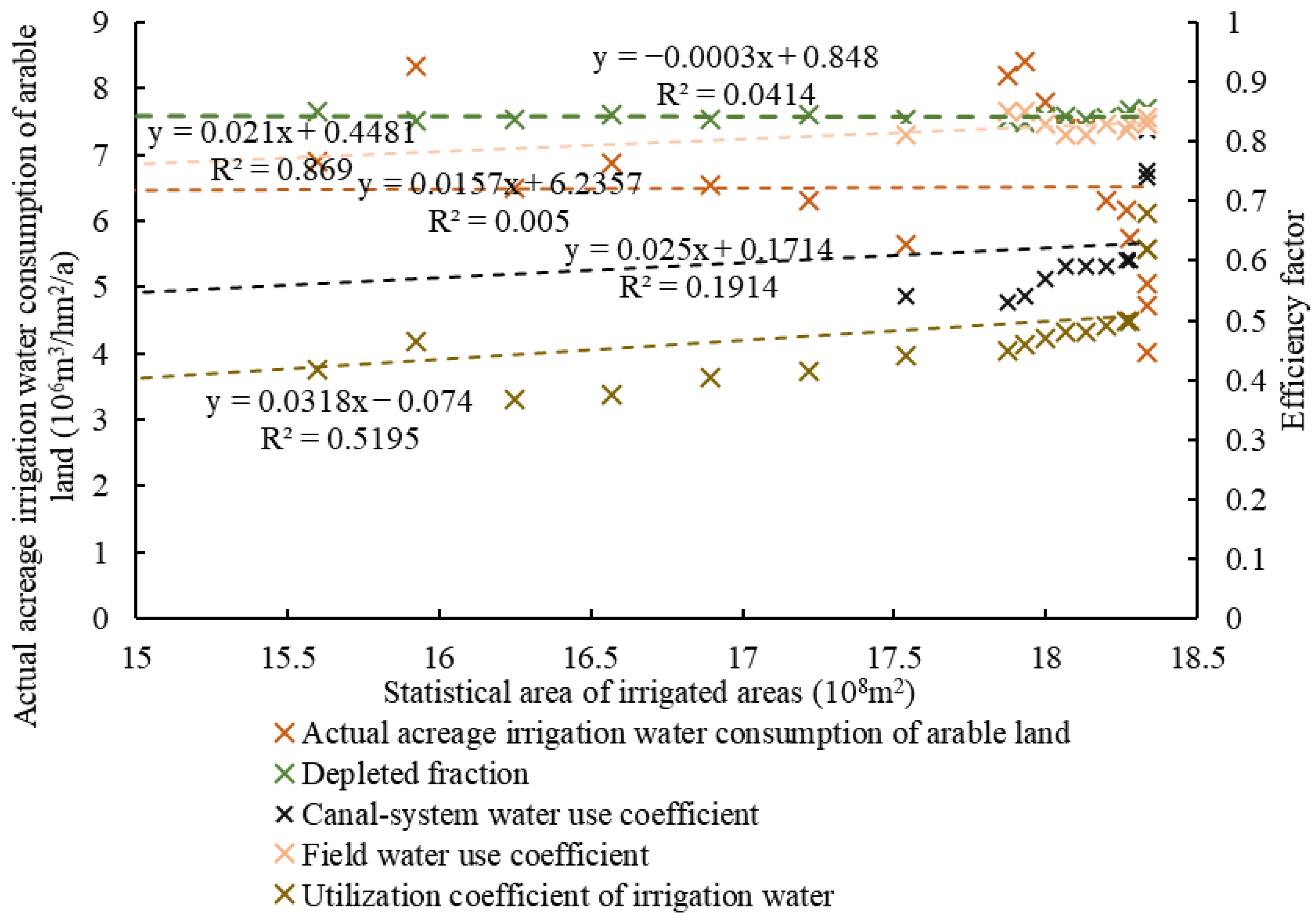
| Data Type | Data Sources | |
|---|---|---|
| Remote sensing data | Remote sensing monitoring data on the current status of 1 km land use in China (1990–2020) | Data Centre for Resource and Environmental Sciences, Chinese Academy of Sciences (https://www.resdc.cn (accessed on 17 March 2023)) |
| Station data | Yanqi meteorological station (1951–2021) | National Meteorological Center (NMC) (https://data.cma.cn (accessed on 28 June 2023)) |
| Statistical data | Irrigation diversion, irrigated area, water use efficiency coefficients, surface water supply, groundwater supply, water consumption by industry, etc. | Bayingolin Statistical Yearbook, Bayingolin Water Resources Bulletin, documentation, etc. |
| Year | Water Use in Agriculture | Industrial Water Consumption | Domestic Water Consumption | Ecological and Environmental Recharge | Total Water Consumption |
|---|---|---|---|---|---|
| 2009 | 12.597 | 0.120 | 0.122 | 0.420 | 13.259 |
| 2010 | 15.955 | 0.199 | 0.222 | 0.258 | 16.634 |
| 2011 | 18.941 | 0.416 | 0.183 | 0.382 | 19.923 |
| 2012 | 17.093 | 0.583 | 0.291 | 0.443 | 18.411 |
| 2013 | 16.829 | 0.499 | 0.299 | 0.137 | 17.764 |
| 2014 | 10.207 | 0.517 | 0.355 | 0.126 | 11.205 |
| 2015 | 15.976 | 0.460 | 0.299 | 0.139 | 16.875 |
| 2016 | 15.451 | 0.395 | 0.314 | 0.274 | 16.434 |
| 2017 | 14.568 | 0.402 | 0.220 | 0.434 | 15.624 |
| 2018 | 12.911 | 0.245 | 0.190 | 0.595 | 13.941 |
| 2019 | 11.580 | 0.202 | 0.188 | 0.839 | 12.808 |
| 2020 | 9.984 | 0.196 | 0.160 | 1.506 | 11.845 |
| Mean | 14.341 | 0.353 | 0.237 | 0.463 | 15.394 |
| Year | Percentage of Water Used in Agriculture in Total Water Consumption | Percentage of Surface Water in Total Water Consumption | Percentage of Groundwater in Total Water Consumption |
|---|---|---|---|
| 2009 | 0.950 | 0.768 | 0.232 |
| 2010 | 0.959 | 0.672 | 0.328 |
| 2011 | 0.951 | 0.699 | 0.301 |
| 2012 | 0.928 | 0.654 | 0.346 |
| 2013 | 0.947 | 0.637 | 0.363 |
| 2014 | 0.911 | 0.814 | 0.186 |
| 2015 | 0.947 | 0.568 | 0.432 |
| 2016 | 0.940 | 0.571 | 0.429 |
| 2017 | 0.932 | 0.575 | 0.425 |
| 2018 | 0.926 | 0.588 | 0.412 |
| 2019 | 0.904 | 0.572 | 0.428 |
| 2020 | 0.843 | 0.647 | 0.353 |
| Mean | 0.928 | 0.768 | 0.232 |
| Year | Water Supply | Water Consumption | ||
|---|---|---|---|---|
| Irrigation Water | Irrigation Water from Groundwater | Irrigation Water from Surface Water | Net Irrigation Water | |
| 1998 | 10.61 | 3.00 | 7.61 | 5.68 |
| 2009 | 24.77 | 2.51 | 22.26 | 12.31 |
| 2010 | 15.65 | 3.21 | 12.45 | 8.78 |
| 2011 | 13.41 | 4.64 | 8.77 | 8.65 |
| 2012 | 11.90 | 4.65 | 7.25 | 8.07 |
| 2013 | 13.15 | 3.51 | 9.65 | 8.09 |
| 2014 | 13.50 | 3.81 | 9.70 | 8.47 |
| 2015 | 14.37 | 4.23 | 10.14 | 9.16 |
| 2016 | 12.45 | 3.69 | 8.77 | 8.03 |
| 2017 | 11.92 | 3.22 | 8.70 | 7.59 |
| 2018 | 12.26 | 3.29 | 8.97 | 8.83 |
| 2019 | 11.59 | 3.20 | 8.39 | 8.43 |
| 2020 | 12.29 | 3.42 | 8.88 | 9.45 |
| Mean | 13.68 | 3.57 | 10.12 | 8.58 |
| Year | Farmland Drainage /(108 m3) | Water Consumption /(108 m3) | Irrigated Area /(108 m2) | Actual Evaporation /(mm) |
|---|---|---|---|---|
| 1998 | 1.93 | 5.18 | 12.07 | 429.12 |
| 2009 | 1.87 | 11.29 | 17.54 | 643.93 |
| 2010 | 2.73 | 7.32 | 17.87 | 409.65 |
| 2011 | 2.80 | 8.36 | 17.93 | 466.10 |
| 2012 | 2.60 | 5.87 | 18.00 | 325.99 |
| 2013 | 2.46 | 6.93 | 18.07 | 383.60 |
| 2014 | 2.46 | 6.62 | 18.13 | 364.89 |
| 2015 | 2.42 | 7.81 | 18.20 | 429.09 |
| 2016 | 2.37 | 6.83 | 18.27 | 373.71 |
| 2017 | 2.20 | 6.39 | 18.28 | 349.45 |
| 2018 | 1.94 | 8.52 | 18.33 | 464.53 |
| 2019 | 1.82 | 9.44 | 18.33 | 515.06 |
| 2020 | 1.76 | 8.95 | 18.33 | 488.22 |
| Mean | 2.26 | 7.65 | 17.64 | 434.10 |
| Year | Diversion Volume I | Effective Rainfall P | Farmland Drainage O | water Consumption E |
|---|---|---|---|---|
| 1980 | 726.08 | 65.10 | 127.39 | 663.78 |
| 1981 | 759.57 | 122.60 | 133.37 | 748.80 |
| 1982 | 731.46 | 73.70 | 128.59 | 676.57 |
| 1983 | 702.15 | 106.40 | 123.21 | 685.35 |
| 1984 | 688.40 | 63.10 | 120.81 | 630.68 |
| 1985 | 674.64 | 16.20 | 118.42 | 572.42 |
| 1986 | 610.65 | 48.80 | 111.84 | 547.60 |
| 1987 | 595.69 | 115.60 | 104.67 | 606.63 |
| 1988 | 604.07 | 115.00 | 106.46 | 612.61 |
| 1989 | 608.85 | 71.20 | 107.06 | 572.99 |
| 1990 | 570.64 | 83.20 | 100.44 | 553.40 |
| 1991 | 549.67 | 94.60 | 96.58 | 547.69 |
| 1992 | 535.87 | 142.10 | 94.37 | 583.60 |
| 1993 | 653.42 | 69.50 | 114.87 | 608.05 |
| 1994 | 528.70 | 61.10 | 92.72 | 497.08 |
| 1995 | 550.88 | 118.10 | 96.83 | 572.15 |
| 1996 | 530.63 | 78.30 | 93.54 | 515.39 |
| 1997 | 557.44 | 96.50 | 97.92 | 556.02 |
| 1998 | 599.02 | 129.80 | 105.31 | 623.51 |
| 1999 | 576.59 | 66.60 | 101.36 | 541.82 |
| 2000 | 668.91 | 104.00 | 117.59 | 655.31 |
| 2001 | 790.48 | 66.70 | 138.97 | 718.21 |
| 2002 | 687.39 | 70.60 | 120.84 | 637.15 |
| 2003 | 689.08 | 124.90 | 121.14 | 692.84 |
| 2004 | 833.05 | 46.50 | 146.45 | 733.10 |
| 2005 | 648.96 | 49.15 | 114.09 | 584.03 |
| 2006 | 687.73 | 92.56 | 120.90 | 659.39 |
| 2007 | 653.74 | 55.64 | 114.93 | 594.46 |
| 2008 | 631.97 | 80.33 | 111.10 | 601.20 |
| 2009 | 563.89 | 47.64 | 99.13 | 512.40 |
| 2010 | 820.42 | 72.10 | 144.23 | 748.29 |
| 2011 | 840.74 | 33.40 | 147.80 | 726.34 |
| 2012 | 779.89 | 87.28 | 137.11 | 730.07 |
| 2013 | 738.79 | 86.83 | 129.88 | 695.73 |
| 2014 | 738.79 | 53.76 | 129.88 | 662.66 |
| 2015 | 630.54 | 62.82 | 110.85 | 582.51 |
| 2016 | 615.91 | 71.42 | 108.28 | 579.06 |
| 2017 | 573.25 | 107.29 | 100.78 | 579.76 |
| 2018 | 505.26 | 52.47 | 88.82 | 468.91 |
| 2019 | 473.06 | 46.13 | 83.16 | 436.03 |
| 2020 | 400.96 | 89.17 | 70.49 | 419.64 |
Disclaimer/Publisher’s Note: The statements, opinions and data contained in all publications are solely those of the individual author(s) and contributor(s) and not of MDPI and/or the editor(s). MDPI and/or the editor(s) disclaim responsibility for any injury to people or property resulting from any ideas, methods, instructions or products referred to in the content. |
© 2023 by the authors. Licensee MDPI, Basel, Switzerland. This article is an open access article distributed under the terms and conditions of the Creative Commons Attribution (CC BY) license (https://creativecommons.org/licenses/by/4.0/).
Share and Cite
Cheng, H.; Liu, D.; Ming, G.; Hussain, F.; Ma, L.; Huang, Q.; Meng, X. Evaluation of Water Balance and Water Use Efficiency with the Development of Water-Saving Irrigation in the Yanqi Basin Irrigation District of China. Agronomy 2023, 13, 2990. https://doi.org/10.3390/agronomy13122990
Cheng H, Liu D, Ming G, Hussain F, Ma L, Huang Q, Meng X. Evaluation of Water Balance and Water Use Efficiency with the Development of Water-Saving Irrigation in the Yanqi Basin Irrigation District of China. Agronomy. 2023; 13(12):2990. https://doi.org/10.3390/agronomy13122990
Chicago/Turabian StyleCheng, Huan, Dengfeng Liu, Guanghui Ming, Fiaz Hussain, Lan Ma, Qiang Huang, and Xianmeng Meng. 2023. "Evaluation of Water Balance and Water Use Efficiency with the Development of Water-Saving Irrigation in the Yanqi Basin Irrigation District of China" Agronomy 13, no. 12: 2990. https://doi.org/10.3390/agronomy13122990
APA StyleCheng, H., Liu, D., Ming, G., Hussain, F., Ma, L., Huang, Q., & Meng, X. (2023). Evaluation of Water Balance and Water Use Efficiency with the Development of Water-Saving Irrigation in the Yanqi Basin Irrigation District of China. Agronomy, 13(12), 2990. https://doi.org/10.3390/agronomy13122990









